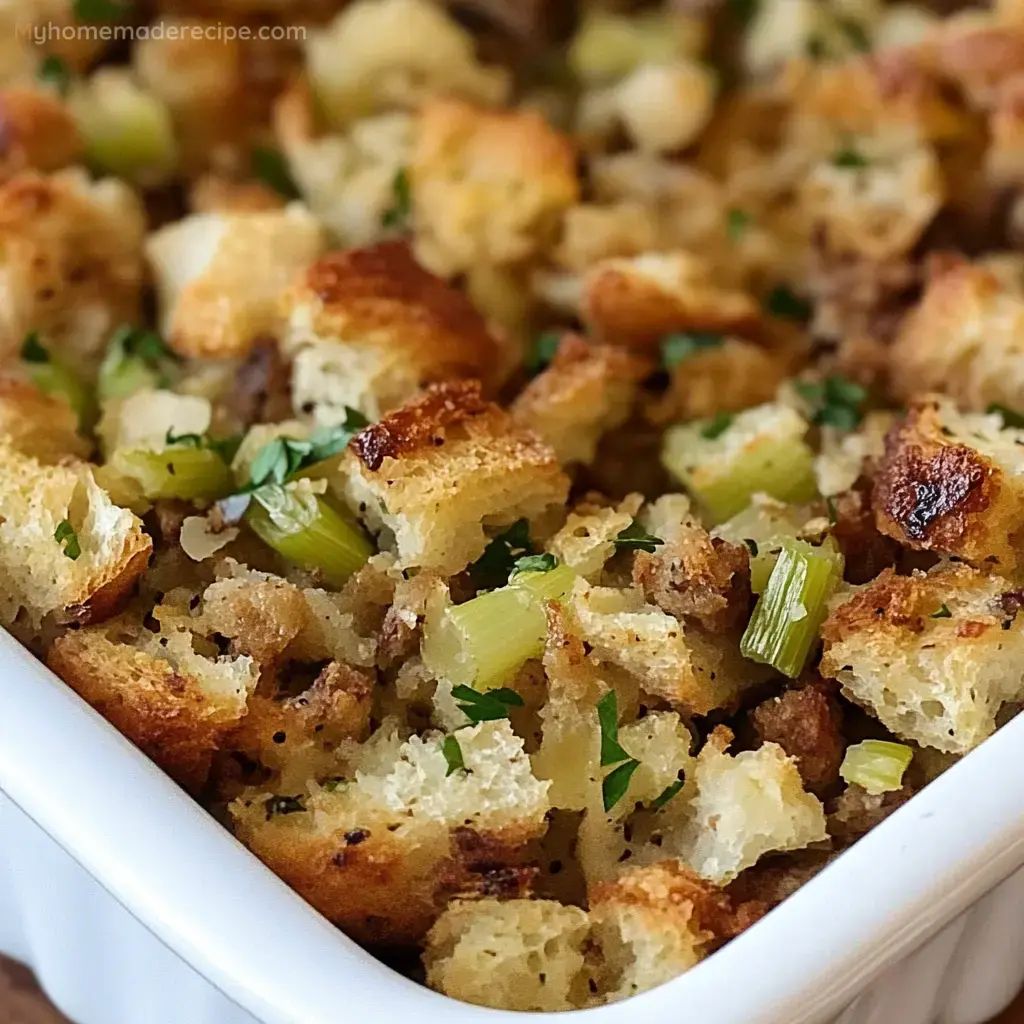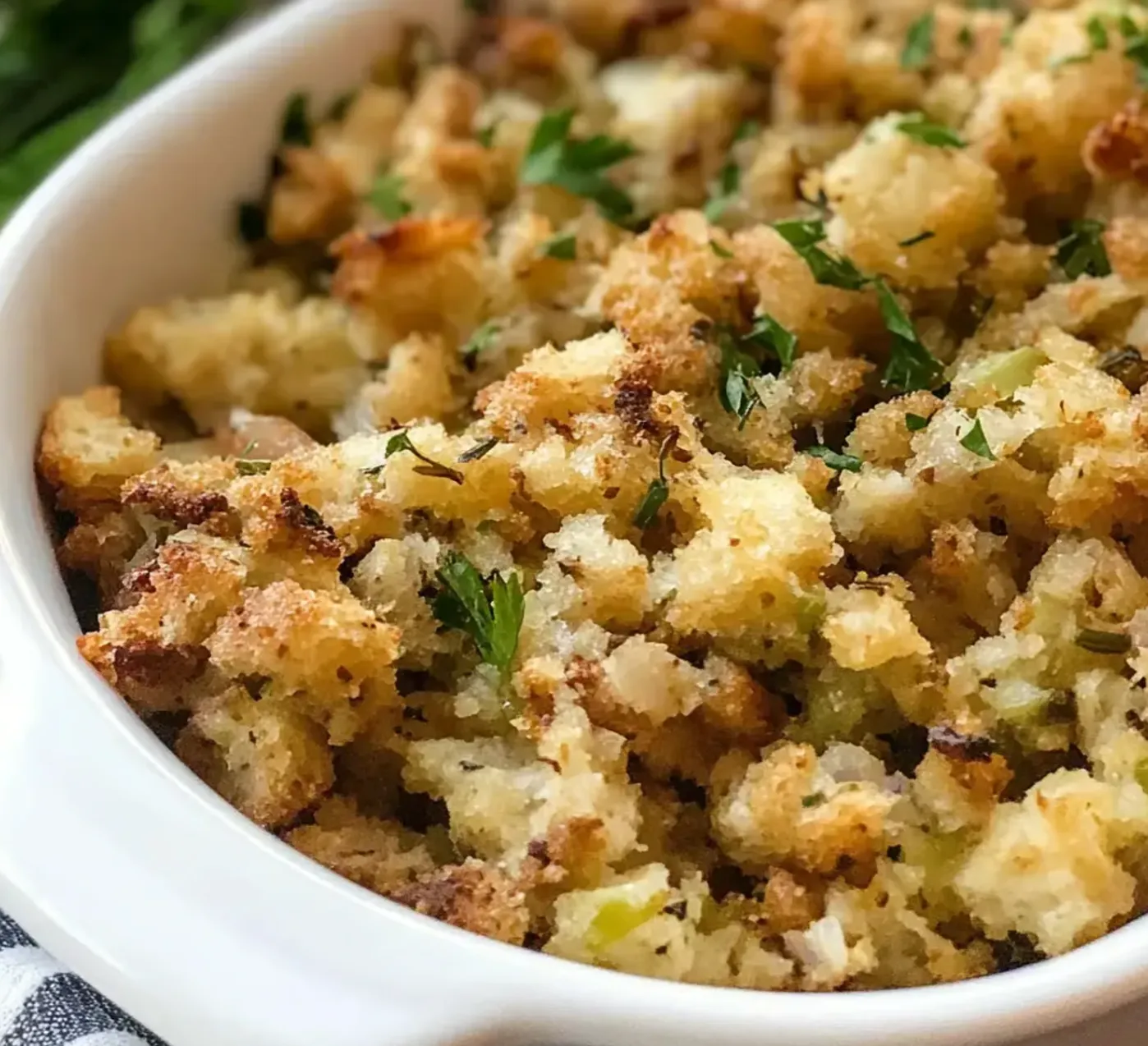 Pin it
Pin it
My kitchen gets filled with this amazing smell of buttered bread, fresh herbs, and cooked veggies every November when I make our family's treasured stuffing recipe. This warm, cozy dish has been handed down from my grandma and turns basic ingredients into something incredible that's been on our Thanksgiving table for years. The trick is letting the bread soak up all those rich herb and broth flavors, giving you those awesome crispy edges while keeping everything moist inside.
I whipped up this stuffing for our early Thanksgiving party last week and everyone crowded my kitchen wanting a taste. My little one kept sneaking crispy bits from the dish corner, and even my mother-in-law asked me how to make it - now that's saying something!
Must-Have Ingredients and Shopping Advice
- Bread Mix (French, sourdough, wheat): Go for fresh bakery loaves and dry them out overnight. This bread combo is what makes our stuffing special
- Yellow Onions: Look for hard onions with tight, glossy skin for the sweetest taste when cooked
- Celery: Go for bright, snappy stalks with fresh leaves for the tastiest base flavors
- Fresh Herbs (sage, thyme, parsley): Choose vibrant green, bouncy leaves for best flavor. Skip anything wilted or yellowish
- Unsalted Butter: Treat yourself to fancy European butter with extra fat content for amazing richness
- Quality Chicken Stock: Make your own if you can, but if buying it, grab low-sodium so you can control the salt
Step-by-Step Cooking Guide
- Step 1: Bread Preparation (Day Before)
- Slice bread into 1-inch chunks and lay them on baking sheets. Let them sit out overnight, giving them a toss now and then so they dry evenly. You want them dry but not super hard.
- Step 2: Aromatics Base (Day Of)
- In a big skillet, melt butter over medium heat till it's bubbly. Toss in your chopped onions and celery, cooking them slowly for 12-15 minutes. Stir every so often until everything's soft and see-through. Add some salt and pepper to build flavor.
- Step 3: Herb Integration
- Throw your freshly chopped herbs into the veggie mix. Cook for 2-3 more minutes to get all those good herb oils flowing. Your kitchen should smell amazing now. Take it off the heat and let it cool a bit.
- Step 4: Assembly
- Put your dried bread cubes in your biggest mixing bowl. Pour the warm veggie-herb mix over everything. Mix gently but well with wooden spoons. Slowly add warm stock, giving the bread time to soak up liquid between pours. Keep mixing until bread is evenly damp but not mushy.
- Step 5: Baking Process
- Put everything in a buttered baking dish without packing it down. Cover with foil, making sure it doesn't touch the stuffing. Bake at 350°F for 30 minutes covered. Take the foil off and bake another 20-30 minutes until it's golden. Let it sit for 10 minutes before digging in.
After years of making this stuffing, I've found that sage really makes it special. My grandma always grew her own sage plants, and I do the same now. The gray-green leaves from my garden add something that store-bought sage just can't match. Just last month my neighbor started growing sage too after trying this stuffing at our fall get-together.
Finding That Perfect Moisture Level
Getting just the right amount of moisture in stuffing is tricky business. Too wet and you've got mush, too dry and it's just toasted bread cubes. I've learned that adding stock bit by bit while gently mixing gives the bread time to soak everything up evenly. Look for bread chunks that feel damp but still keep their shape when you give them a little squeeze.
Prepping Ahead To Save Time
What's great about this recipe is how it fits into busy holiday cooking. I often get the dried bread cubes ready up to three days early and keep them in paper bags. The veggie-herb mix can be made a day before and kept in the fridge. Just warm it up a little before mixing with the bread. This prep work has kept me sane during many holiday meals.
Memories Baked Into Every Serving
Whenever I cook this stuffing, I think about standing in my grandma's kitchen, watching her mix everything without measuring cups. She taught me to trust my gut - to feel when the moisture was right and smell when the herbs were perfectly cooked in the butter. Now my kids help me make it, keeping our family's tradition of cooking with heart and feel alive.
Keeping Leftovers Fresh
In our house, we sometimes look forward to leftover stuffing as much as the fresh-baked version. Keep it covered in your fridge for up to four days. When reheating, sprinkle on a few drops of stock, cover with foil, and warm in a 325°F oven. The best part? Those edges get even crunchier the second time around.
 Pin it
Pin it
This stuffing shows what I love most about cooking - taking simple stuff and turning it into something amazing through technique and patience. I've tried tons of versions over the years, but this one's still my go-to Thanksgiving stuffing. The way it brings together those crunchy edges, soft middle, and perfect seasoning makes it more than just a side - it's what our holiday table is all about.
